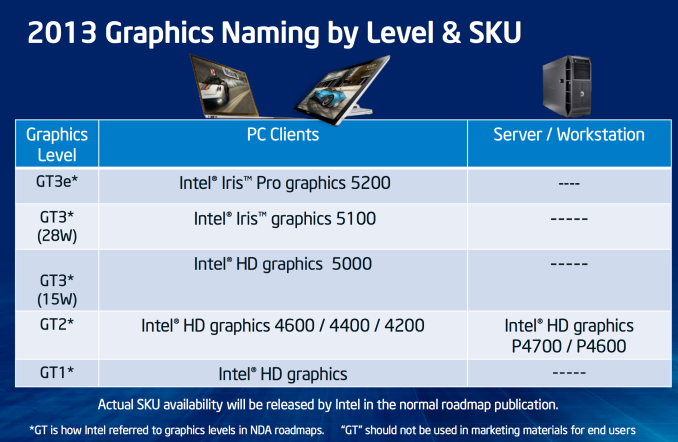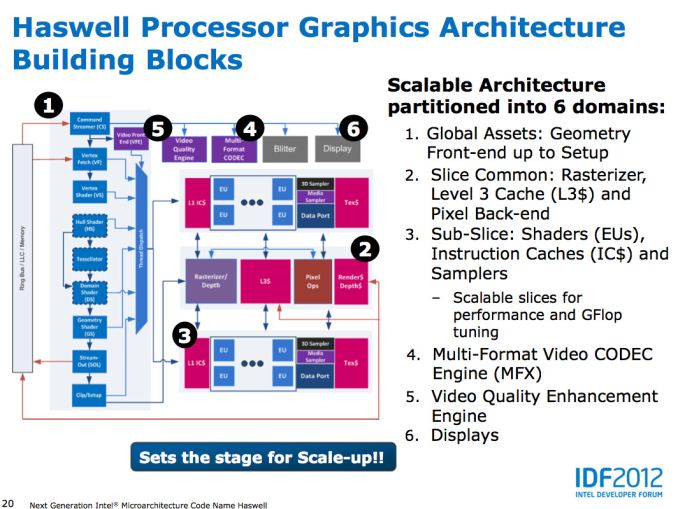Intel Iris Pro 5200 Graphics Review: Core i7-4950HQ Tested
by Anand Lal Shimpi on June 1, 2013 10:01 AM ESTHaswell GPU Architecture & Iris Pro
In 2010, Intel’s Clarkdale and Arrandale CPUs dropped the GMA (Graphics Media Accelerator) label from its integrated graphics. From that point on, all Intel graphics would be known as Intel HD graphics. With certain versions of Haswell, Intel once again parts ways with its old brand and introduces a new one, this time the change is much more significant.
Intel attempted to simplify the naming confusion with this slide:
While Sandy and Ivy Bridge featured two different GPU implementations (GT1 and GT2), Haswell adds a third (GT3).
Basically it boils down to this. Haswell GT1 is just called Intel HD Graphics, Haswell GT2 is HD 4200/4400/4600. Haswell GT3 at or below 1.1GHz is called HD 5000. Haswell GT3 capable of hitting 1.3GHz is called Iris 5100, and finally Haswell GT3e (GT3 + embedded DRAM) is called Iris Pro 5200.
The fundamental GPU architecture hasn’t changed much between Ivy Bridge and Haswell. There are some enhancements, but for the most part what we’re looking at here is a dramatic increase in the amount of die area allocated for graphics.
All GPU vendors have some fundamental building block they scale up/down to hit various performance/power/price targets. AMD calls theirs a Compute Unit, NVIDIA’s is known as an SMX, and Intel’s is called a sub-slice.
In Haswell, each graphics sub-slice features 10 EUs. Each EU is a dual-issue SIMD machine with two 4-wide vector ALUs:
| Low Level Architecture Comparison | ||||||||||||||||
| AMD GCN | Intel Gen7 Graphics | NVIDIA Kepler | ||||||||||||||
| Building Block | GCN Compute Unit | Sub-Slice | Kepler SMX | |||||||||||||
| Shader Building Block | 16-wide Vector SIMD | 2 x 4-wide Vector SIMD | 32-wide Vector SIMD | |||||||||||||
| Smallest Implementation | 4 SIMDs | 10 SIMDs | 6 SIMDs | |||||||||||||
| Smallest Implementation (ALUs) | 64 | 80 | 192 | |||||||||||||
There are limitations as to what can be co-issued down each EU’s pair of pipes. Intel addressed many of the co-issue limitations last generation with Ivy Bridge, but there are still some that remain.
Architecturally, this makes Intel’s Gen7 graphics core a bit odd compared to AMD’s GCN and NVIDIA’s Kepler, both of which feature much wider SIMD arrays without any co-issue requirements. The smallest sub-slice in Haswell however delivers a competitive number of ALUs to AMD and NVIDIA implementations.
Intel had a decent building block with Ivy Bridge, but it chose not to scale it up as far as it would go. With Haswell that changes. In its highest performing configuration, Haswell implements four sub-slices or 40 EUs. Doing the math reveals a very competent looking part on paper:
| Peak Theoretical GPU Performance | ||||||||||||||||
| Cores/EUs | Peak FP ops per Core/EU | Max GPU Frequency | Peak GFLOPs | |||||||||||||
| Intel Iris Pro 5100/5200 | 40 | 16 | 1300MHz | 832 GFLOPS | ||||||||||||
| Intel HD Graphics 5000 | 40 | 16 | 1100MHz | 704 GFLOPS | ||||||||||||
| NVIDIA GeForce GT 650M | 384 | 2 | 900MHz | 691.2 GFLOPS | ||||||||||||
| Intel HD Graphics 4600 | 20 | 16 | 1350MHz | 432 GFLOPS | ||||||||||||
| Intel HD Graphics 4000 | 16 | 16 | 1150MHz | 294.4 GFLOPS | ||||||||||||
| Intel HD Graphics 3000 | 12 | 12 | 1350MHz | 194.4 GFLOPS | ||||||||||||
| Intel HD Graphics 2000 | 6 | 12 | 1350MHz | 97.2 GFLOPS | ||||||||||||
| Apple A6X | 32 | 8 | 300MHz | 76.8 GFLOPS | ||||||||||||
In its highest end configuration, Iris has more raw compute power than a GeForce GT 650M - and even more than a GeForce GT 750M. Now we’re comparing across architectures here so this won’t necessarily translate into a performance advantage in games, but the takeaway is that with HD 5000, Iris 5100 and Iris Pro 5200 Intel is finally walking the walk of a GPU company.
Peak theoretical performance falls off steeply as soon as you start looking at the GT2 and GT1 implementations. With 1/4 - 1/2 of the execution resources as the GT3 graphics implementation, and no corresponding increase in frequency to offset the loss the slower parts are substantially less capable. The good news is that Haswell GT2 (HD 4600) is at least more capable than Ivy Bridge GT2 (HD 4000).
Taking a step back and looking at the rest of the theoretical numbers gives us a more well rounded look at Intel’s graphics architectures :
| Peak Theoretical GPU Performance | ||||||||||||||||
| Peak Pixel Fill Rate | Peak Texel Rate | Peak Polygon Rate | Peak GFLOPs | |||||||||||||
| Intel Iris Pro 5100/5200 | 10.4 GPixels/s | 20.8 GTexels/s | 650 MPolys/s | 832 GFLOPS | ||||||||||||
| Intel HD Graphics 5000 | 8.8 GPixels/s | 17.6 GTexels/s | 550 MPolys/s | 704 GFLOPS | ||||||||||||
| NVIDIA GeForce GT 650M | 14.4 GPixels/s | 28.8 GTexels/s | 900 MPolys/s | 691.2 GFLOPS | ||||||||||||
| Intel HD Graphics 4600 | 5.4 GPixels/s | 10.8 GTexels/s | 675 MPolys/s | 432 GFLOPS | ||||||||||||
| AMD Radeon HD 7660D (Desktop Trinity, A10-5800K) | 6.4 GPixels/s | 19.2 GTexels/s | 800 MPolys/s | 614 GFLOPS | ||||||||||||
| AMD Radeon HD 7660G (Mobile Trinity, A10-4600M) | 3.97 GPixels/s | 11.9 GTexels/s | 496 MPolys/s | 380 GFLOPS | ||||||||||||
Intel may have more raw compute, but NVIDIA invested more everywhere else in the pipeline. Triangle, texturing and pixel throughput capabilities are all higher on the 650M than on Iris Pro 5200. Compared to AMD's Trinity however, Intel has a big advantage.












177 Comments
View All Comments
virgult - Saturday, August 31, 2013 - link
Nvidia Kepler plays Crysis 3 well but it sucks insanely hard at computing and rendering.Eric S - Wednesday, July 3, 2013 - link
It appears to do compute better then graphics (and ECC memory is a plus for compute). That is exactly what pros will be looking for. Apple doesn't cater to the gaming market with these machines even if they should play most games fine. A dedicated gaming machine would be built much different then this.jasonelmore - Sunday, June 2, 2013 - link
This, I dont know about anyone else, but i'm not dropping 2 grand or $2700 with upgrades on a 15 incher that does not have dedicated graphics.Another problem i see is the 13" Retina only uses duals, and if they did use this quad with GT3e silicon, then the price of of the 13" will go up at least $150 since the i7's and i5's the 13" currently use, are sub $300 parts.
The only solution i see is Apple offering it as a build to order/max upgrade option, and even then they risk segmentation across the product line.
fteoath64 - Monday, June 3, 2013 - link
"can't sell a $2000 laptop without a dedicated GFX". Absolutely true, especially when the GT3e is still a little slower than the 650M. So the 750M tweaked a few mhz higher will do nicely for the rMBP. The 13 incher will get a boost with the GT3e CPU. So a slight upgrade to lower power cpu maybe worthwhile to some. Improvement to 1080p eyesight camera would be a given for the new rMBP.Eric S - Wednesday, July 3, 2013 - link
You can drop discrete graphics when that $2000+ laptop is using builtin graphics with the same price premium and number of transistors of the discrete chip. I'm almost positive the discrete will go away. I have a feeling that Apple had a say in optimizations and stressed OpenCL performance. That is probably what they will highlight when they announce a new MacBook Pro.xtc-604 - Saturday, June 8, 2013 - link
I really hope that Apple continues to treat the rMBP 15 as a flagship. Giving it iGPU only would be a deal breaker for many professionals. Atleast in haswell's current form. Until Intel can make an IGPU that atleast matches or exceeds performance at high resolutions, it is still a no go for me.Eric S - Wednesday, July 3, 2013 - link
Why is that a deal breaker? The Iris 5200 is better then a discrete chip for compute (OpenCL). If you are doing 3D rendering, video editing, photoshop, bioinformatics, etc. that is what you should care about. It also has ECC memory unlike a discrete chip so you know your output is correct. How fast it can texture triangles is less important. It still has plenty of power in that area for any pro app. This is not designed to be a gaming machine. Not sure why anyone would be surprised it may not be optimized for that.Eric S - Monday, July 1, 2013 - link
You never know, but I doubt it. They will have trouble with the ports on the side if they make it smaller. I think it is more likely the space saving will go to additional battery. They may be able to get similar battery life increases to the Air with the extra space.mikeztm - Tuesday, June 4, 2013 - link
Notice that the 13" 2012 rMBP is a little thicker than the 15" version. Quad core in 13 inch may be planned at the very beginning.axien86 - Saturday, June 1, 2013 - link
Look at the overheating issues that come with i5/i7 Razer notebooks and finding the same heating noticed in their Haswell notebook press event several days ago.
If Apple decides to use these Haswells which put out heat in a concentrated area and in very thin outlines, you are essentially computing over a mini-bake oven.